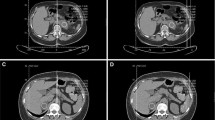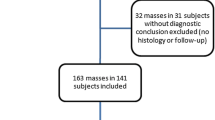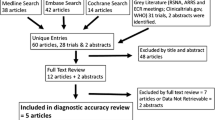Abstract
Objectives
To investigate whether the histogram analysis method of characterizing adrenal nodules as adenomas is affected by increased noise with modern CT technique, and if an extension that allows for noise correction will improve diagnostic performance.
Materials and methods
This is a HIPAA-compliant, IRB-approved retrospective study performed on 58 total patients. The first group of 29 patients had 33 adrenal lesions that were pathology-proven non-adenomas. The second group had 29 patients with 33 pathology-proven or presumed adenomas based on established imaging criteria. The nodules were evaluated using the histogram method, mean attenuation method, and a Gaussian model-based algorithm without (uncorrected Gaussian algorithm) and with correction (corrected Gaussian algorithm) for image noise. Sensitivity, specificity, and accuracy for identifying adenoma were derived.
Results
There were no significant differences in identifying adenoma from non-adenoma when using the histogram analysis method and the uncorrected Gaussian algorithm, both of which had low specificities of 42.4% and 47.0%, respectively (p = 0.30). Adding noise correction to the Gaussian algorithm resulted in a statistically significant increase in specificity relative to the histogram method (86.4% vs. 42.4%, p < 0.001). The corrected Gaussian algorithm improved sensitivity compared to the mean attenuation method (71.2% vs. 54.5%, p < 0.001), but had lower specificity (86.4% vs. 100%, p < 0.001), and similar overall accuracy (78.8% vs. 77.3%, p = 0.74).
Conclusion
With modern low-dose CT technique, the specificity scores of the histogram method for discrimination of adrenal adenomas and non-adenomas are lower than with previous higher dose scans. The specificity and accuracy of a histogram-equivalent method can be increased mathematically through image noise correction, and the corrected Gaussian algorithm has improved sensitivity to the mean attenuation with similar accuracy albeit with lower specificity. Although this suggests limited utility for histogram analysis in adrenal nodule characterization, our study demonstrates the potential mathematical application for other noise-dependent CT characterization methods.






Similar content being viewed by others
References
Song JH, Chaudhry FS, Mayo-Smith WW (2008) The incidental adrenal mass on CT: prevalence of adrenal disease in 1,049 consecutive adrenal masses in patients with no known malignancy. AJR Am J Roentgenol 190:1163-8.
Lee MJ, Hahn PF, Papanicolaou N, et al. (1991) Benign and malignant adrenal masses: CT distinction with attenuation coefficients, size, and observer analysis. Radiology 179:415-8.
Caoili EM, Korobkin M, Francis IR, et al. (2002) Adrenal masses: characterization with combined unenhanced and delayed enhanced CT. Radiology 222:629-33.
Boland GW, Blake MA, Hahn PF, Mayo-Smith WW (2008) Incidental adrenal lesions: principles, techniques, and algorithms for imaging characterization. Radiology 249:756-75.
Bae KT, Fuangtharnthip P, Prasad SR, Joe BN, Heiken JP (2003) Adrenal masses: CT characterization with histogram analysis method. Radiology 228:735-42.
Jhaveri KS, Wong F, Ghai S, Haider MA (2006) Comparison of CT histogram analysis and chemical shift MRI in the characterization of indeterminate adrenal nodules. AJR Am J Roentgenol 187:1303-8.
Jhaveri KS, Wong F, Ghai S, Haider MA (2006) Comparison of CT histogram analysis and chemical shift MRI in the characterization of indeterminate adrenal nodules. AJR Am J Roentgenol 187:1303-8.
Remer EM, Motta-Ramirez GA, Shepardson LB, Hamrahian AH, Herts BR (2006) CT Histogram Analysis in Pathologically Proven Adrenal Masses. American Journal of Roentgenology 187:191-6.
Perri M, Erba P, Volterrani D, et al. (2011) Adrenal Masses in Patients With Cancer: PET/CT Characterization With Combined CT Histogram and Standardized Uptake Value PET Analysis. American Journal of Roentgenology 197:209-16.
Ho LM, Paulson EK, Brady MJ, Wong TZ, Schindera ST (2008) Lipid-poor adenomas on unenhanced CT: does histogram analysis increase sensitivity compared with a mean attenuation threshold? AJR Am J Roentgenol 191:234-8.
Power SP, Moloney F, Twomey M, James K, O'Connor OJ, Maher MM (2016) Computed tomography and patient risk: Facts, perceptions and uncertainties. World journal of radiology 8:902-15.
Hsu LD, Wang CL, Clark TJ Characterization of Adrenal Adenoma by Gaussian Model-Based Algorithm. Current problems in diagnostic radiology 45:312-8.
Rocha TO, Albuquerque TC, Nather JC, Jr., et al. (2018) Histogram Analysis of Adrenal Lesions With a Single Measurement for 10th Percentile: Feasibility and Incremental Value for Diagnosing Adenomas. AJR Am J Roentgenol 211:1227-33.
Lin MF, Chang-Sen LQ, Heiken JP, Pilgram TK, Bae KT (2015) Histogram analysis for characterization of indeterminate adrenal nodules on noncontrast CT. Abdominal imaging 40:1666-74.
Lubner MG, Smith AD, Sandrasegaran K, Sahani DV, Pickhardt PJ (2017) CT Texture Analysis: Definitions, Applications, Biologic Correlates, and Challenges. Radiographics : a review publication of the Radiological Society of North America, Inc 37:1483-503.
Lubner MG, Stabo N, Abel EJ, Del Rio AM, Pickhardt PJ (2016) CT Textural Analysis of Large Primary Renal Cell Carcinomas: Pretreatment Tumor Heterogeneity Correlates With Histologic Findings and Clinical Outcomes. AJR Am J Roentgenol 207:96-105.
Author information
Authors and Affiliations
Corresponding author
Ethics declarations
Conflict of interest
One of the authors, Mr. Hippe, has several research grants to disclose: Research Grant, Koninklijke Philips NV; Research Grant, General Electric Company; Research Grant, Toshiba America Medical Systems. These grants did not support this study. None of the other authors have financial disclosures or conflicts of interest to declare.
Ethical approval
The institutional review board at University of Washington Medical Center approved this study.
Electronic supplementary material
Below is the link to the electronic supplementary material.
Rights and permissions
About this article
Cite this article
Clark, T.J., Hsu, L.D., Hippe, D. et al. Evaluation of diagnostic accuracy: multidetector CT image noise correction improves specificity of a Gaussian model-based algorithm used for characterization of incidental adrenal nodules. Abdom Radiol 44, 1033–1043 (2019). https://doi.org/10.1007/s00261-018-1871-y
Published:
Issue Date:
DOI: https://doi.org/10.1007/s00261-018-1871-y




